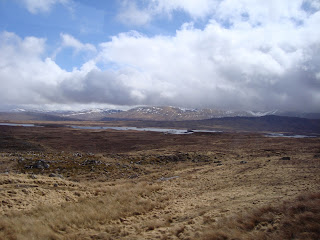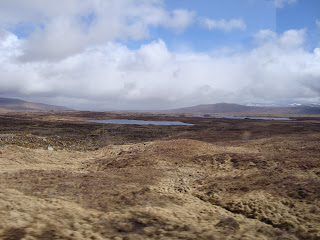I returned earlier this evening from a weekend spent on the Isle of Skye with my study abroad program. We departed early Friday morning and there were about 160 of us (all American study abroad students) on four separate buses. Similar to the Highlands weekend in October and the trip to Argyll in March, the surroundings and tours are beautiful - but often exhausting. I think too, as there are only three of us of the 160 who are studying for the full-year, this semester's trips have felt a bit stranger than the Highlands in October. Certainly having been here eight months versus three is a part of it and as we didn't attend the January orientation, I struggle with remembering and knowing the names of the other students. However, it was an enjoyable trip and a beautiful part of Scotland that I'm so pleased I was able to see.
We departed a little past seven on Friday morning, and it was certainly a rough morning waking up. There were some drunken shenanigans occurring in our corridor by students who didn't live there until quite a ways past 3am on Friday morning and it was a constant battle of my fellow residents and kitchenmates asking again and again for the group to please be quiet or go elsewhere. Despite the dizzying exhaustion when I woke to my alarm a bit past six on Friday, the fully risen morning sun was beautiful and so motivating. I soon found myself asleep on the bus and woke about thirty minutes after departing St. Andrews as we crossed the bridge into Dundee.
Compared to (majestic/historic/safe/enormously beautiful) St. Andrews, Dundee doesn't always receive the kindest reputation...but as we crossed the Firth of Tay (a river that runs into the North Sea) into Dundee on Friday morning it was looking pretty nice. :)
Later, we stopped in Perth, a central Scotland city (the population is a little over 20,000 - immediately categorizing the community as a town - but in July 2012 during Queen Elizabeth II's Diamond Jubilee Scotland tour she granted Perth 'Scotland's seventh city'). While there, we bought lunch at an enormous ASDA (The Scotland version of Wal-Mart) that seemingly carried every food product known to man, before reuniting with the three other coaches filled with students arriving from Edinburgh, Glasgow and Stirling. We met our weekend tour guide, Mirena, who just like Ross - our Highlands tour guide in October - told an abundance of stories of the Scots being persecuted by the English. In fact, I think that was the educational theme of both weekends. After two more hours of driving and a drastically changing landscape, we had reached the Scottish Highlands. Fife, Perthshire and Angus - all central and eastern Scottish counties - are made up of fertile soil and rolling hills of wheat and barley. The highlands though - while often green in photographs - are much rockier and mountainous with far less fertile soil than the rest of Scotland. There are certainly large patches of evergreen and douglas fir trees (brought over from North America!) but much of the Highlands is home to huge amounts of brush, sheep, highland cows, wild red deer and cashmere goats. I imagine the green comes out in the summer months after spring rain and extended daylight. Scotland has had a much colder and longer winter and spring than usual this year, and I thought the Highlands looked similar in October and April.
The western Highlands.
As we entered the highlands, we stopped at the Queen's view, an area that was a common holiday spot of Queen Victoria. While there, we learned why today's Highland Cows are overwhelmingly orange.
A highland cow in October.
Supposedly while visiting the Highlands, Queen Victoria saw black, brown white and orange Highlands cows. She remarked that the orange were her favorite and highland cow owners immediately began breeding only orange cows. Not until the 1980s did a desire for the multi-colored cows come back and serious cow genealogy began. :) I can happily report too, that deep into the Highlands we did spot black, brown and white cows. Interesting too, the long hair the cows sport is not for warmth but to shield the rain.
The Queen's view.
myself and Julie.
As we drove farther north, the scenery became so so beautiful near the lochs.
We stopped at Culloden, a battleground just south of Inverness, the capitol of the Highlands. We visited Culloden also in October and unfortunately I left my camera on the bus this past weekend. I can only compare the battlefield to the Scottish version of Gettysburg. A massive battle occurred there on April 16, 1746 involving the British Government troops and the Clans of the Highlands, also known as 'The Highlanders'. The Highlanders wanted to restore the Scottish (and Catholic) House of Stewart to the British throne and overthrow the Protestant House of Hanover (which reigned from George I in 1714 until the death of Queen Victoria in 1901). Nearly every Highland Scottish clan volunteered to fight the British Government troops at Culloden for the renewal of a Scottish monarch to the throne. In the very brief battle, the Highland Clans suffered 2000 casualties in 50 minutes while the government forces experienced 50 casualties. Sadly too, English forces banned two distinct pieces of Scottish culture after the battle with the enactment of the Dress Act of 1746. Bagpipes and Tartan were illegal to possess until the repeal of the act in the 1780s. Today, mass graves divided by clan litter the battlefield. Several of the students present (and the battlefield's many visitors) have Scottish last names (like MacGregor, MacDonald, Campbell, or Drummond) tracing back to the clans buried in Culloden. It was interesting to observe the sadness and remembrance surrounding the Battle (and many, many other Highland battles and massacres fought between the English and the Scottish or the Protestants and the Catholics) relating to the current referendum for Scottish Independence. Interestingly too, up until 1900, an individual born in Scotland held dual French-Scottish citizenship because of the close alliance the two nations held for several centuries based in fighting England as a common enemy. Mirena described Scots as 'having very long memories'.
From there, we crossed the central Highlands and then headed west for the Isle of Skye in far northwestern Scotland.
Getting closer...
And later that evening, we arrived in Skye!
We stayed in Broadford, a southern Skye town of about 800. The island itself is about one-third the size of New Hampshire with a population around 9-10,000. In the west it borders the Atlantic and dozens of smaller island surround it. It reminded me quite a bit of the coast of Maine.














No comments:
Post a Comment